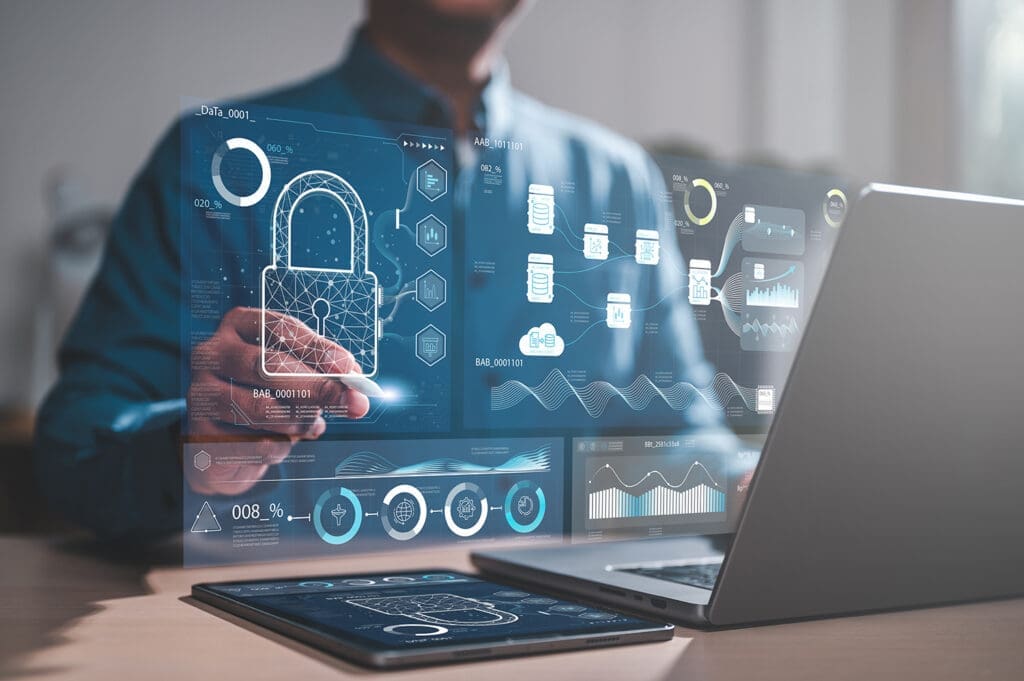

If you manage a construction company, a utility service, or a local government agency in the Midwest, remote data security is essential for protecting your data in remote work environments. Whether you oversee field crews, coordinate inspection teams, or handle community records, your data needs to be safe wherever your staff works. The risks are real, from lost devices to unsecured Wi-Fi connections. These seven remote data security tips can help you reduce those risks and keep your operations running smoothly without disruption.
1. Maintain Strong Passwords
Using strong passwords across all platforms is key to preventing unauthorized access. A secure password combines upper- and lowercase letters, numbers, and symbols, and avoids personal details. Data security tools like Bitwarden or 1Password help your team manage credentials safely. This reduces security risks, avoids downtime from account lockouts, and supports overall workforce data security, allowing your staff to stay productive while protecting your systems from breaches.
2. Require Multi-Factor Authentication (MFA)
Multi factor authentication MFA adds a second layer during login, like a code from a mobile app or text message, to block unauthorized users even if passwords are stolen. It strengthens your security controls, protects network security, and supports secure access to job systems and client portals. By using MFA, your team stays protected against cyber threats at any location, while you safeguard sensitive data, maintain strong data security, and uphold client trust in remote and field-based operations.
3. Use Secure VPNs for Remote Access
Public Wi-Fi and unsecured home networks leave your data vulnerable to cyber threats. A business-grade VPN is a powerful data security tool that encrypts connections and protects sensitive data from interception. Whether using personal devices or mobile devices, your team can connect securely from any location. This supports strong network security, prevents data leaks, and keeps files safe outside of corporate networks, helping you reduce the risk and improve overall workforce data security in remote environments.
4. Train Your Team on Cyber Hygiene
Your staff is central to your company’s data security. Clicking malicious links or downloading infected files can trigger serious security risks. Regular training helps employees spot red flags, recognize phishing attempts, and avoid unsafe downloads. It also builds awareness around managing personal devices, mobile devices, and cloud tools securely. By creating a culture of accountability, you reduce the risk of breaches and support workforce data security without disrupting daily operations. Training is one of the most effective security solutions available.
5. Encrypt Files on All Devices
Data encryption keeps information unreadable if a device is lost or stolen, protecting laptops, tablets, and mobile devices used in the field. Built-in encryption data tools, such as BitLocker or FileVault, add an extra layer of data security for sensitive materials, including permits or contracts. Even with theft or loss, your files remain secure. For external sharing, apply data masking to further reduce the risk of exposure and strengthen workforce data security across remote teams.
6. Back Up Critical Data Automatically
Backing up your data ensures that you have a second copy in case something goes wrong. Whether a laptop crashes or files are deleted, you can restore important data without delays. Using cloud-based solutions like Carbonite or Backblaze, backups run automatically to protect field reports, inspection records, and project files. These data security tools protect against device failure and security risks, enabling your business to remain secure and operational while supporting long-term data security for your workforce across all locations.
7. Control Device Access and Permissions
Not every employee needs full access. By setting access controls and limiting permissions, you reduce the risk of accidental changes or deletions. Using reliable data security tools helps you monitor connected devices, enforce screen locks, and remotely wipe lost hardware. Whether using company-issued or personal devices, you maintain control over data access. This strengthens workforce data security and ensures only authorized users handle sensitive data, supporting safer operations in remote or hybrid environments.
Ready to Secure Your Remote Operations?
Protecting business data doesn’t stop at the office. When your team works from different locations, having the right remote security measures in place makes all the difference. The right plan helps you stay prepared, avoid disruptions, and give your clients confidence in how you handle their information.
Let Pearl Solutions Group help you take the next step. We’ll guide you through practical remote data security solutions that match your workflow and security needs. Contact us today to build a remote data protection strategy that keeps your business strong, connected, and secure.
